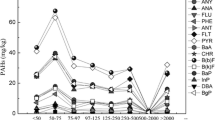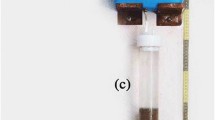Abstract
In this study, the parameters influencing p-cresol removal efficiency in soil washing method were investigated. Primarily, extraction efficiencies of three Tween series surfactants (Tween 20, Tween 60, Tween 80) with 10 mM concentration were compared. Tween 80 showed the best results since its value (55%) was 4% and 13% higher than that of Tween 60 and Tween 20. The impact of mixed surfactant on extraction rate was examined by employing a mixture of Tween 80 and one anionic surfactant (sodium dodecyl sulfate) with different molar ratio as the main washing solution. The results denoted that the molar ratio of 3:2 (SDS:Tween80) could enhance the extraction rate up to 38% compared to using SDS and Tween 80 alone. Regarding the initial p-cresol concentration in the collected sample, the cleanup level (390 mg/kg) could only be achieved using the mixed-surfactant. Thus, the minimum required surfactant concentrations to hit the target level was calculated to be 3.54 g/L of Tween 80 and 2.105 g/L of SDS (molar ratio of 0.27 SDS:Tween80). Studying the role of surfactant concentration indicated that its increment from 10 mM to 20 mM, which is way above all the reagents’ critical micelle concentration (CMC), does not affect the removal rate considerably. The same results were obtained comparing the effect of washing time in three different levels (30 min, 60 min and 90 min). However, temperature showed to be a more significant parameter as it could enhance the results up to 20% (for SDS).








Similar content being viewed by others
References
Anku WW, Mamo MA, Govender PP. Phenolic compounds in water: sources, reactivity, toxicity and treatment methods. Phenolic Compd sources Importance Appl First Ed InTech 2017, pp. 419–443.
Rosas JM, Vicente F, Santos A, et al. Soil remediation using soil washing followed by Fenton oxidation. Chem Eng J. 2013;220:125–32.
U.S. Environmental Protection Agency. Integrated Risk Information System (IRIS) on 3-methylphenol. Washington, DC: National Center for Environmental Assessment, Office of Research and Development; 1999.
U.S. Environmental Protection Agency. Integrated Risk Information System (IRIS) on 4-methylphenol. Washington, DC: National Center for Environmental Assessment, Office of Research and Development; 1999.
U.S. Environmental Protection Agency. Integrated Risk Information System (IRIS) on 2-methylphenol. Washington, DC: National Center for Environmental Assessment, Office of Research and Development; 1999.
De Smet R, Van Kaer J, Van Vlem B, et al. Toxicity of free p-cresol: a prospective and cross-sectional analysis. Clin Chem. 2003;49:470–8.
Tallur PN, Megadi VB, Kamanavalli CM, et al. Biodegradation of p-cresol by Bacillus sp. strain PHN 1. Curr Microbiol. 2006;53:529–33.
Agency for Toxic Substances and Disease Registry (ASTDR). Toxicological Profile for Cresols. Atlanta: U.S. Department of Health and Human Services, Public Health Service, https://www.atsdr.cdc.gov/toxprofiles/tp34.pdf (2008).
Huguenot D, Mousset E, van Hullebusch ED, et al. Combination of surfactant enhanced soil washing and electro-Fenton process for the treatment of soils contaminated by petroleum hydrocarbons. J Environ Manage. 2015;153:40–7.
Paria S, Yuet PK. Solubilization of naphthalene by pure and mixed surfactants. Ind Eng Chem Res. 2006;45(10):3552–8.
Peng S, Wu W, Chen J. Removal of PAHs with surfactant-enhanced soil washing: Influencing factors and removal effectiveness. Chemosphere. 2011;82:1173–7.
Cheng M, Zeng G, Huang D, et al. Advantages and challenges of Tween 80 surfactant-enhanced technologies for the remediation of soils contaminated with hydrophobic organic compounds. Chem Eng J. 2017;314:98–113.
Lee DH, Kim ES, Chang HW. Effect of Tween surfactant components for remediation of toluene-contaminated groundwater. Geosci J. 2005;9:261–7.
Carini M, Facino RM, Chimico I, et al. Cosmetics and toiletries. Chromatography. 1995;3:2511–26.
Zhao B, Zhu L, Li W, et al. Solubilization and biodegradation of phenanthrene in mixed anionic-nonionic surfactant solutions. Chemosphere. 2005;58:33–40.
Ahn CK, Kim YM, Woo SH, et al. Soil washing using various nonionic surfactants and their recovery by selective adsorption with activated carbon. J Hazard Mater. 2008;154:153–60.
Rosas JM, Vicente F, Santos A, et al. Enhancing p-cresol extraction from soil. Chemosphere. 2011;84:260–4.
Li Y, Liao X, Huling SG, et al. The combined effects of surfactant solubilization and chemical oxidation on the removal of polycyclic aromatic hydrocarbon from soil. Sci Total Environ. 2019;647:1106–12.
Chi F-H. Remediation of polycyclic aromatic hydrocarbon-contaminated soils by nonionic surfactants: Column experiments. Environ Eng Sci. 2011;28:139–45.
Ali N, Bilal M, Khan A, et al. Effective exploitation of anionic, nonionic, and nanoparticle-stabilized surfactant foams for petroleum hydrocarbon contaminated soil remediation. Sci Total Environ. 2020;704:135391.
Karthick A, Roy B, Chattopadhyay P. A review on the application of chemical surfactant and surfactant foam for remediation of petroleum oil contaminated soil. J Environ Manag. 2019;243:187–205.
Peluffo M, Pardo F, Santos A, et al. Use of different kinds of persulfate activation with iron for the remediation of a PAH-contaminated soil. Sci Total Environ. 2016;563:649–56.
Wang P, Keller AA. Partitioning of hydrophobic pesticides within a soil – water – anionic surfactant system. Water Res. 2009;43:706–14.
López-Vizcaíno R, Alonso J, Cañizares P, et al. Electroremediation of a natural soil polluted with phenanthrene in a pilot plant. J Hazard Mater. 2014;265:142–50.
Zhou W, Zhu L. Enhanced desorption of phenanthrene from contaminated soil using anionic/nonionic mixed surfactant. Environ Pollut. 2007;147:350–7.
Gitipour S, Mohebban A, Ghasemi S, et al.: Evaluation of effective parameters in washing of PAH-contaminated soils using response surface methodology approach. Int J Environ Sci Technol. Epub ahead of print 2019. https://doi.org/10.1007/s13762-019-02368-6.
Shi Z, Chen J, Liu J, et al. Anionic–nonionic mixed-surfactant-enhanced remediation of PAH-contaminated soil. Environ Sci Pollut Res. 2015;22:12769–74.
Lee DH, Chang HW, Cody RD. Synergism effect of mixed surfactant solutions in remediation of soil contaminated with PCE. Geosci J. 2004;8:319–23.
Guo H, Liu Z, Yang S, et al. The feasibility of enhanced soil washing of p-nitrochlorobenzene (pNCB) with SDBS/Tween80 mixed surfactants. J Hazard Mater. 2009;170:1236–41.
López J, Iturbe R, Torres LG. Washing of soil contaminated with PAHs and heavy petroleum fractions using two anionic and one ionic surfactant: Effect of salt addition. J Environ Sci Heal - Part A Toxic/Hazardous Subst Environ Eng. 2004;39:2293–306.
Deshpande S, Shiau BJ, Wade D, et al. Surfactant selection for enhancing ex situ soil washing. Water Res. 1999;33:351–60.
ASTM: ASTM D2216-10 - Standard Test Methods for Laboratory Determination of Water. (Moisture) Content of Soil and Rock by Mass. ASTM International, http://www.astm.org/cgi-bin/resolver.cgi?D2216-10 (2010). Accessed 19 July 2019.
ASTM. ASTM D4972–19 Standard Test Methods for pH of Soils, http://www.astm.org/cgi-bin/resolver.cgi?D4972-19 (2019).
ASTM: ASTM D2974-13, Standard Test Methods for Moisture, Ash, and Organic Matter of Peat and Other Organic Soils. ASTM. International. http://www.astm.org/cgi-bin/resolver.cgi?D2974-13 (2013). Accessed 19 July 2019.
ASTM: ASTM-D422-63-(2007)e2, Standard Test Method for Particle-Size Analysis of Soils (Withdrawn 2016). ASTM. International. http://www.astm.org/cgi-bin/resolver.cgi?D422-63(2007)e2 (2007). Accessed 19 July 2019.
ASTM. ASTM D2487-17, Standard practice for classification of soils for engineering purposes (Unified Soil Classification System). ASTM International, http://www.astm.org/cgi-bin/resolver.cgi?D4972-19 (2017). Accessed 19 July 2019.
Mohebbi M, Gitipour S, Madadian E. Solidification/Stabilization of Cresol-Contaminated Soil: Mechanical and Leaching Behavior. Soil Sediment Contam. 2013;22:783–99.
Gitipour S, Narenjkar K, Farvash ES, et al. Soil flushing of cresols contaminated soil: Application of nonionic and ionic surfactants under different pH and concentrations. J Environ Heal Sci Eng. 2014;12:1–6.
Asadzadeh F, Maleki-Kaklar M, Soiltanalinejad N, et al. Central composite design optimization of zinc removal from contaminated soil, using citric acid as biodegradable chelant. Sci Rep. 2018;8:1–8.
Li H, Qu R, Li C, et al. Selective removal of polycyclic aromatic hydrocarbons (PAHs) from soil washing effluents using biochars produced at different pyrolytic temperatures. Bioresour Technol. 2014;163:193–8.
Gharibzadeh F, Rezaei Kalantary R, Nasseri S, et al. Reuse of polycyclic aromatic hydrocarbons (PAHs) contaminated soil washing effluent by bioaugmentation/biostimulation process. Sep Purif Technol. 2016;168:248–56.
Method for the. Determination of Phenol. 1986, 1–25.
Paria S. Surfactant-enhanced remediation of organic contaminated soil and water. Adv Colloid Interface Sci. 2008;138:24–58.
Mahdi ES, Sakeena MH, Abdulkarim MF, et al. Effect of surfactant and surfactant blends on pseudoternary phase diagram behavior of newly synthesized palm kernel oil esters. Drug Des Devel Ther. 2011;5:311–23.
Alcántara MT, Gómez J, Pazos M, et al. PAHs soil decontamination in two steps: Desorption and electrochemical treatment. J Hazard Mater. 2009;166:462–8.
Alcántara MT, Gómez J, Pazos M, et al. Combined treatment of PAHs contaminated soils using the sequence extraction with surfactant-electrochemical degradation. Chemosphere. 2008;70:1438–44.
Zhang M, Zhu L. Effect of SDBS-Tween 80 mixed surfactants on the distribution of polycyclic aromatic hydrocarbons in soil-water system. J Soils Sediments. 2010;10:1123–30.
Mohamed A, Mahfoodh ASM. Solubilization of naphthalene and pyrene by sodium dodecyl sulfate (SDS) and polyoxyethylenesorbitan monooleate (Tween 80) mixed micelles. Colloids Surfaces A Physicochem Eng Asp. 2006;287:44–50.
Zhu L, Feng S. Synergistic solubilization of polycyclic aromatic hydrocarbons by mixed anionic-nonionic surfactants. Chemosphere. 2003;53:459–67.
Von Lau E, Gan S, Ng HK, et al. Extraction agents for the removal of polycyclic aromatic hydrocarbons (PAHs) from soil in soil washing technologies. Environ Pollut. 2014;184:640–9.
Han M, Ji G, Ni J. Washing of field weathered crude oil contaminated soil with an environmentally compatible surfactant, alkyl polyglucoside. Chemosphere. 2009;76:579–86.
Kalali A, Ebadi T, Rabbani A, et al. Response surface methodology approach to the optimization of oil hydrocarbon polluted soil remediation using enhanced soil washing. Int J Environ Sci Technol. 2011;8:389–400.
Acknowledgements
This research is partially funded by University of Tehran.
Author information
Authors and Affiliations
Contributions
Conceptualization, S.G. and P.Y.; Methodology, S.G. and P.Y.; Validation, S.G., P.Y. and A.M.; Formal Analysis, A.M.; Investigation, P.Y. and M.A.; Resources, P.Y.; Data Curation, A.M.; Writing – Original Draft Preparation, A.M.; Writing – Review & Editing, A.M., M.A. and R.M.D.; Visualization, A.M.; Supervision, S.G.; Project Administration, M.A., R.M.D. and M.R.; Funding Acquisition, R.M.D. and M.R. All Authors have read and approved the final manuscript.
Corresponding author
Ethics declarations
Conflict of interest
The authors declare that they have no conflict of interest.
Additional information
Publisher's Note
Springer Nature remains neutral with regard to jurisdictional claims in published maps and institutional affiliations.
Rights and permissions
About this article
Cite this article
Mohebban, A., Yaghoobzadeh, P., Gitipour, S. et al. Applicability of an anionic-nonionic surfactant in p-cresol contaminated soil washing: Finding the optimal mixing ratio. J Environ Health Sci Engineer 18, 1207–1216 (2020). https://doi.org/10.1007/s40201-020-00538-0
Received:
Revised:
Accepted:
Published:
Issue Date:
DOI: https://doi.org/10.1007/s40201-020-00538-0




